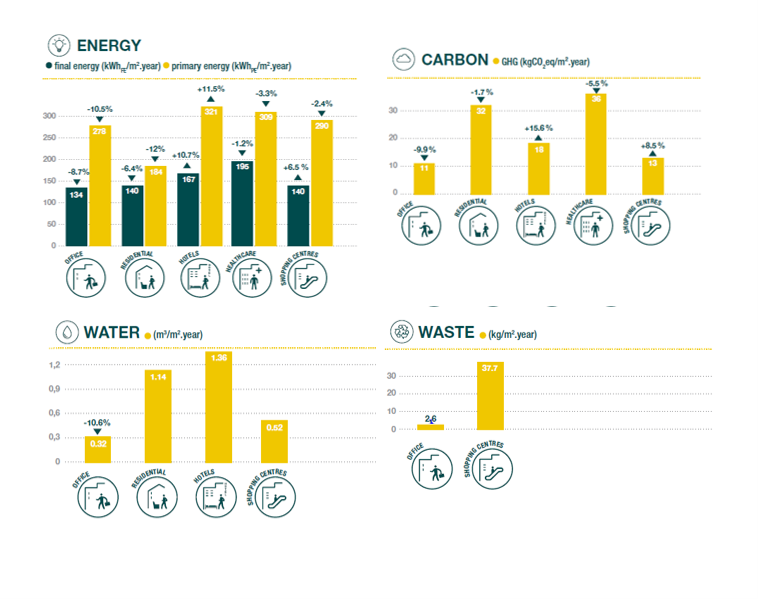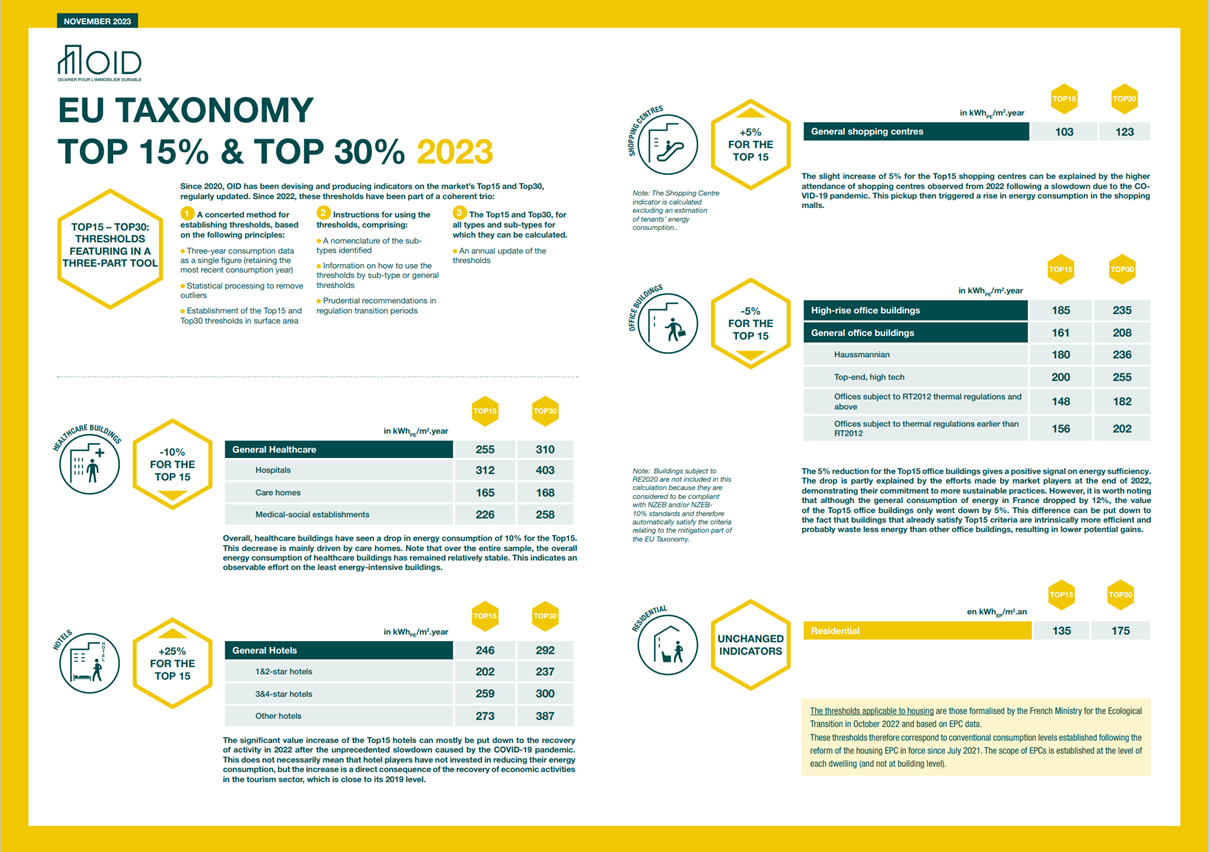Against a backdrop of sobriety being promoted by the public authorities, and with the European Union having raised its decarbonisation target to 2030, how is the actual energy consumption of French buildings changing? To answer this question as for the past 10 years, the OID (Green Building Observatory) has published the 2023 results of its Barometer of the energy and environmental performance of buildings. Offices, shopping centres, hotels, healthcare buildings and residential properties are all scrutinised. The profiles of buildings included in the Top15 and Top30 for the European Taxonomy’s mitigation challenge are also presented.
Barometer 2023: what are the results?
Calculated for offices, shopping centres, hotels, healthcare and residential assets, the changes in the indicators give a mixed picture.
The first finding is that shopping centres, and especially hotels, have seen their final energy consumption increase by 6.5% and 10.7% respectively. Indeed, 2022 was the first almost complete year of normalisation following the health crisis. Hotel occupancy rates have soared, while shopping centre footfall is back on the rise. The thresholds presented therefore reflect levels that are more in line with the cruising speed of these business sectors.
For their part, healthcare facilities saw a measured fall in consumption (-1.2% in final energy), reflecting the continuing strong pressure on buildings and their use.
Lastly, offices and housing confirmed the long-term trend towards lower energy consumption: on the office side, final energy consumption fell by 8.7% to 134 kWh/m² per year, while housing fell by 6.4% to 140 kWh/m² per year.
Despite these good results, the rate of decarbonisation is still falling short of the targets to be achieved: -2% per year on average since 2010, while the increased European ambitions now require a rate of more than 6% per year! The gap is therefore widening between the stated objectives and the reality of the sector’s decarbonisation. Still falling short of the objectives to be achieved: -2% per year on average since 2010, while the increased European ambitions now require a rate of more than 6% per year! The gap is therefore widening between the stated objectives and the reality of the sector’s decarbonisation.

Which commercial buildings are included in the Top15 and Top30?
As it does every year, the IDO is publishing an update of its Top15 and Top30 figures for the European Taxonomy’s mitigation target. The levels observed reflect the cyclical trends in 2022, depending on the specific features observed for the main indicators.
While 2022 was a pivotal year (Ukraine, energy prices, sobriety, etc.), the 2023 update of the Top15 and Top30 is of particular importance. For existing buildings, players will give priority to calculating their rate of alignment on the basis of the Top15 by applying the DNSH adaptation. The Top15 is therefore crucial for steering the financing strategy for the ecological transition of buildings.
The analysis of buildings used to benchmark these Top15 and Top30 is paradoxical. It is not easy to identify the clear characteristics of buildings with low energy consumption. Offices and shopping centres are more certified than average. Shopping centres are over-represented in the Paris region. Health care properties are located more in the regions and regional cities than the overall base.
Finally, an analysis of the energy mix of these different samples shows the limitations of the (primary) energy consumption indicator as a mitigation criterion. As Sabine Brunel, deputy director of the OID, points out, « the mitigation criterion does not allow us to discriminate between buildings on the basis of the low-carbon nature of their heating energy ». In this respect, the buildings studied are no better or worse than French buildings as a whole.

The Top15 and Top30 of commercial buildings are available here
The executive summary of the Barometer (in English) is available here
The complete Barometer (in French) is available here
About us:
OID (the Green Building Observatory) is an independant space for discussions between actors of the real estate industry, on sustainable development. Our purpose is to imagine responsible real estate. OID has more than a hundred members and partners, among them the leaders of commercial real estate in France over the whole value chain. OID is an association contributing to the rise of ESG topics in France and abroad, through an action programme in the field and towards the public sector. www.o-immobilierdurable.fr
The Green Building Observatory (OID) has launched a European programme in 2021, the European Sustainable Real Estate Initiative (ESREI), that brings together real estate stakeholders to discuss ESG issues and the situation regarding ESG regulations across Europe.
ESREI is now sponsored by Advenis REIM, AEW, Amundi Asset Management, Axa Investment Managers, BNP Paribas Real Estate, CBRE Global Investors, Ivanhoe Cambridge, La Française REIM, Mazars, Ofi Invest and Pimco Prime Real Estate. Contact the ESREI team at esrei@o-immobilierdurable.fr if you are interested to join us!




